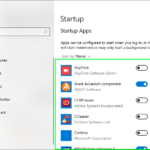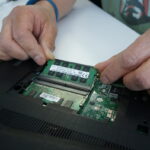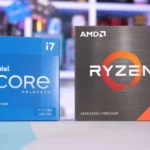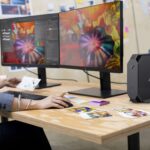People who love technology! Does your trusty Desktop Computer ever feel like it’s running through digital molasses? You’re not the only one. I’ve dealt with this annoying problem many times as a seasoned blogger who has been writing about technology for years. That’s why I’m so excited to read the complete guide on How to Speed up Your Desktop Computer.
We all use our computers for work, fun, and staying in touch with others. A slow desktop computer can make you less productive and make you very angry. This detailed article isn’t just a quick-fix list; it’s a plan for bringing your computer back to life and making it feel like new again. We’ll look at a variety of methods, from simple software changes to more complicated hardware issues, all with the same goal: to help you Speed up Your Desktop Computer.
Think of this as your best source of information, full of useful tips you can use right away. Let’s get started on the path to a faster, more responsive computer experience.
Why Your Desktop Computer Is Slowing Down
It’s important to know the “why” before we get into the “how-to.” There are a number of things that can make a Desktop Computer run slowly. The first step in solving the problem and learning How to Speed up Your Desktop Computer is to find out what caused it.
Software that uses a lot of resources: A lot of programs use a lot of system resources (CPU, RAM, disk space) even when you’re not using them. These background tasks can make things run very slowly.
Full Hard Drive: When your hard drive is almost full, your operating system has less room to store temporary files and virtual memory, which slows things down.
Old Operating System and Drivers: Older versions of software may not work as well and may not be optimized for newer hardware or security threats. Drivers that are out of date can also cause problems with compatibility and slow down performance.
Malware and Viruses: Bad software can use up system resources, run processes you don’t want, and even hurt your system files, which can slow it down a lot.
Too Many Startup Programs: A lot of programs that start up automatically when you turn on your desktop computer can make it take a long time to start up and make it slow down overall.
Fragmented Hard Drive (HDD): As time goes on, files on a regular hard drive (HDD) can become fragmented, which means that different parts of the same file are stored in different places. This makes the system work harder to get to the whole file. (Note: This is less of a problem with newer Solid State Drives, or SSDs.)
Insufficient Hardware: Sometimes, the hardware in your Desktop Computer might not be powerful enough for the tasks you’re trying to do. A lack of RAM or an old processor can slow down performance.
To effectively use strategies to Speed up Your Desktop Computer, you need to know what these common problems are. Let’s talk about the solutions now.
Quick Changes to Your Software to Make Your Desktop Computer Faster
These are some of the fastest and easiest things you can do right now to make your Desktop Computer work better right away and learn How to Speed up Your Desktop Computer.
Ending Programs and Processes That Aren’t Needed
This may seem obvious, but people often forget about it. Look at the system tray and taskbar. Are there programs running that you aren’t using right now? Shut them.
If you want to go even further, open your Task Manager (Ctrl+Shift+Esc on Windows or Cmd+Option+Esc on macOS). You can see a list of all the processes that are running and the resources they are using under the “Processes” tab. Find any programs or background processes that are using a lot of CPU or memory and that you don’t need to be running. Be careful when ending processes because some of them are necessary for the system to work. A quick online search can help you learn more about a process if you’re not sure what it is.
Tip for the real world: Get into the habit of closing apps you’re not using. Check your Task Manager from time to time to find and stop processes that use a lot of resources but aren’t necessary.
Getting rid of programs you don’t want
Over time, we tend to collect software that we don’t use anymore. These programs can use up a lot of disk space and sometimes run processes in the background that make your Desktop Computer run slower.
On Windows: Click on “Control Panel,” then “Programs,” and then “Programs and Features.” Look through the list and remove any programs you don’t know about or don’t need anymore.
For macOS: Open “Finder,” go to the “Applications” folder, and drag the app you don’t want to the “Trash.” After that, get rid of the trash. Some programs may leave behind leftover files, so you might want to use a special uninstaller tool to clean up more thoroughly.
Tip for the Real World: Look over the programs you have installed every so often and uninstall any that you haven’t used in a few months.
How to Handle Startup Programs
As we said before, having too many startup programs can make your computer take a long time to start up and respond. Let’s learn How to Speed up Your Desktop Computer by taking care of these.
For Windows: Press Ctrl+Shift+Esc to open Task Manager. Then, go to the “Startup” tab and turn off any programs that aren’t needed.
On macOS: Click on “System Preferences,” then “Users & Groups,” and then click on the “Login Items” tab for your user account. Uninstall any programs that you don’t need to start up automatically.
Useful Tip: Only let certain programs start up on their own. Allow only those that you use right after you log in.
Getting Rid of Temporary Files
Your operating system and programs make temporary files that can build up over time and make your system messy, which could slow it down.
On Windows: Use the “Disk Cleanup” tool that comes with Windows. To find it, go to the Start Menu, choose your main drive (usually C:), and check the boxes next to “Temporary files,” “Temporary Internet Files,” and any other categories you want to clean.
On a Mac: Click “Go” in the menu bar of “Finder” and then “Go to Folder…” Type ~/Library/Caches and delete everything in the folders inside. Be careful and only delete files in folders that are specific to an application if you know what you’re doing. You can also use cleaning tools made by other companies.
Tip for the Real World: Run Disk Cleanup (Windows) or clear your cache folders by hand (macOS) once a month or so.
More Advanced Optimization Methods to Improve Performance
Let’s now look at some more advanced methods that can help Speeding up Your Desktop Computer a lot.
Only Defragmenting Your Hard Drive (HDD)
As was said before, fragmentation can make regular hard disk drives (HDDs) work more slowly. Defragmenting rearranges the data on the drive so that the system can get to files more quickly.
On Windows: In the Start Menu, type “Defragment and Optimize Drives,” choose your HDD, and then click “Optimize.”
On macOS: macOS automatically defragments your hard drive in the background, so you usually don’t have to do it yourself.
Helpful Hint: If you have an older Desktop Computer with an HDD, defragment it every now and then, especially if you often move, delete, or install big files. Do not defragment your SSD because it can shorten its life.
How to Update Your Drivers and Operating System
For your computer’s performance, stability, and security, it’s important to keep your operating system and device drivers up to date.
The Operating System:
For Windows, click “Check for updates” in “Settings,” then “Update & Security,” and then “Windows Update.”
For macOS, click on “Software Update” in “System Preferences.”
Drivers: Updates to your operating system often include updates to your drivers, but you may need to do this by hand from time to time, especially for your graphics card. To get the most up-to-date drivers for your hardware, go to the manufacturer’s website (for example, NVIDIA, AMD, or Intel).
Tip for Real Life: Turn on automatic updates for your operating system so that you always have the most recent security patches and performance improvements. Check for and update the drivers for your most important hardware parts on a regular basis.
Looking for viruses and malware
Malicious software can make your Desktop Computer run very slowly. You must run a full scan with a trusted antivirus and anti-malware program.
Windows: Windows Defender, which is now called Microsoft Defender Antivirus, comes with Windows and offers good basic protection. For more complete protection, think about using an antivirus program from a third party. Do scans on a regular basis.
macOS: Most people think that macOS is safer, but it can still get malware. Think about using a good anti-malware program and running scans every so often.
Tip for the Real World: Set up your antivirus software to do full system scans on a regular basis. Be careful about clicking on links that look suspicious or downloading files from places you don’t trust. Think about using a browser add-on that helps you find bad websites.
Changing the Visual Effects
Windows and macOS have a lot of visual effects that can make the user interface look better, but they can also use up system resources. Turning off some of these effects can help Speed up Your Desktop Computer, especially if it doesn’t have a lot of processing power or an old graphics card.
On Windows: In the Start Menu, type “Adjust the appearance and performance of Windows” to find it. You can turn off most effects by choosing “Adjust for best performance” on the “Visual Effects” tab. You can also change the settings to turn off certain effects.
For macOS: Click on “System Preferences,” then “Accessibility,” and then “Display.” Check the boxes for “Reduce motion” and “Reduce transparency.”
Tip: Try turning off different visual effects to see which ones make the biggest difference in performance without making your experience much worse.
Hardware upgrades that will make a big difference in performance
It might be time to think about upgrading your hardware if software tweaks aren’t giving you the performance boost you want. Even though this costs money, it can make your Desktop Computer much faster and more responsive.
Switching to an SSD (Solid State Drive)
This is probably the most important thing you can do to Speed up Your Desktop Computer. SSDs read and write data much faster than regular hard drives. This means that your computer will boot up, load applications, and respond to commands much faster.
Things to think about: Pick an SSD that has enough space for your operating system, the programs you use most often, and your important files. If you need to, you can keep your old HDD for extra storage.
Adding More RAM (Random Access Memory)
RAM is where your computer keeps data that it is currently using. If you often run more than one program at a time or work with big files, not enough RAM can slow things down because your computer has to use slower virtual memory (disk space).
Things to think about: Look at the specs for your motherboard to see what kind and how much RAM it can handle. Adding more RAM can make it much easier to do more than one thing at a time.
Getting a New Graphics Card (for Gaming and Other Graphics-Heavy Tasks)
If you use your desktop computer for gaming, video editing, or other tasks that require a lot of graphics, upgrading your graphics card can make a big difference in how well it works and how smoothly the frames move.
Things to think about: Make sure your power supply can handle a more powerful graphics card and that the card will work with your motherboard.
Upgrading Your CPU (Processor)
The processor is like the brain of your computer. A CPU upgrade can make your computer run faster, but it’s often the hardest and most expensive upgrade because it might also need a compatible motherboard.
Things to think about: Find out which CPUs work with your motherboard socket type. Think about whether the extra work and money are worth the performance boost.
Tip for Real Life: Putting an SSD in your computer and adding more RAM should be your top priorities, as these usually make the biggest difference in how well it works for everyday tasks.
How to Keep Your Performance at Its Best: Daily Habits
Learning How to Speed up Your Desktop Computer isn’t something you do once; it’s about making good habits that will keep it running well over time.
Restart Regularly: A simple restart can often fix temporary performance problems by closing all open programs and clearing the temporary memory.
Clean Up Your Desktop: A messy desktop with a lot of files and shortcuts can make your computer start up a little slower. Put your files in folders.
Be Careful About What Software You Install: Only install software that you really need. Don’t download programs from places you don’t trust.
Keep an eye on how much resources you’re using: Check your Task Manager (Windows) or Activity Monitor (macOS) from time to time to see if any apps or processes are using too many resources.
Make sure to back up your data often: Backing up your data is important even if it doesn’t have anything to do with speed. This is because system failures or other problems may require you to do a clean installation of your operating system.
You can help make sure that your Desktop Computer keeps running smoothly and efficiently by making these small changes to your daily routine.
Have a desktop computer that works faster and better
It doesn’t have to be hard to speed up a slow Desktop Computer. You can greatly improve your computer’s performance and have a much smoother computing experience by learning about the most common reasons for slowdowns and following the helpful advice in this guide on How to Speed up Your Desktop Computer.
The goal is the same, no matter if you start with small software changes or think about bigger hardware upgrades: to make your Computer work better for you. So, do something today, use these tips, and say goodbye to lag and hello to a faster, more responsive Desktop Computer!
https://bigezwehotv.rw/category/trends
Resources:
- Microsoft Support: Tips to improve PC performance in Windows 10 https://support.microsoft.com/en-us/windows/tips-to-improve-pc-performance-in-windows-10-0bcf782a-a6b8-6991-da02-4f77ccfc34ad
- Apple Support: If your Mac runs slowly https://support.apple.com/en-us/HT203353







